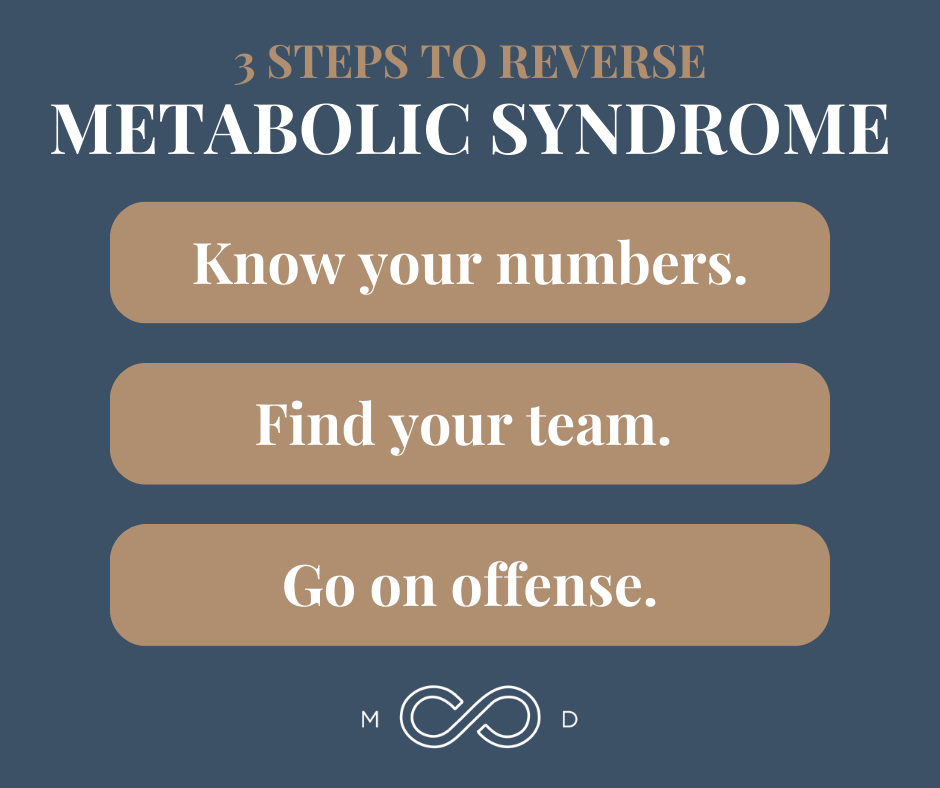Download file | Play in new window | |
If you’ve read our blog or listened to our podcast before, you’ve heard Jen and I talk about metabolic syndrome as a significant contributor to disease and an antagonist to longevity.
This topic is so significant for health that we’ll dedicate this entire post to it, answering questions like:
- What is metabolic syndrome?
- How do you diagnose metabolic syndrome?
- Can you reverse metabolic syndrome?
- How do you treat metabolic syndrome?
These are important questions, because metabolic syndrome is all around us. In the United States, at least one in three adults currently meets the criteria for a metabolic syndrome diagnosis, and that number is on the rise.
Let’s start with a quick review of what metabolic syndrome is and why it matters.
What Is Metabolic Syndrome?
In medicine, we love to name to things. And when we can’t come up with a clever name for a cluster of symptoms, we just call it a syndrome. Metabolic syndrome is simply what we call the appearance of several specific conditions at one time.
Together, these conditions raise your risk for coronary heart disease, diabetes, stroke, and other serious health problems. In fact, you can think of metabolic syndrome as the gateway disease to all the health problems you most want to avoid.
Outside of smoking, metabolic syndrome is the single greatest variable you can manage to have the greatest impact on your overall health, vitality, and longevity.
So, what does it look like? If you have at least three of the following five conditions, you qualify for a metabolic syndrome diagnosis:
- Hypertension — average blood pressure above 130/85 over time
- Elevated blood sugar — fasting glucose over 100
- Low HDL — below 50 for women and 40 for men
- Elevated triglycerides — levels over 150
- Truncal obesity — waist circumference (measured at your belly button) over 35 inches in women and 40 inches in men
Think OFFENSE: The Mindset to Avoid Metabolic Syndrome
Our bodies are made up of fine-tuned, carefully balanced systems and processes. While it doesn’t take much for those systems to get out of whack, the changes usually happen slowly. Diabetes doesn’t appear overnight, for example. It’s a slow burn toward disease.
In the past, we’ve talked about having an offensive versus defensive mindset. To avoid metabolic syndrome, an offensive mindset is critical.
Why? Just look around you.
We live in an obesogenic environment. Fast food is everywhere. Delivery drivers meet us at our door with dinner. Our schedules are too full to cook daily meals or exercise regularly and appropriately.
We’re stressed, we’re busy, and we’re nutritionally challenged. But none of it triggers warning bells because the consequences are so gradual. If you’re playing defense, you won’t know to take action until you’re already in trouble.
The default physiology for all developed nations in 2023 and beyond is metabolic syndrome. If you don’t go on the offense, you’ll be swept down the same path as everyone else — toward becoming a metabolic syndrome statistic and dramatically increasing your risk for the chronic diseases that kill humans.
You need a plan, an offensive strategy, to fight against the tide.
Can Metabolic Syndrome Be Reversed?
Okay, maybe you didn’t know about metabolic syndrome before. Or maybe you didn’t know how to take an offensive approach to it, and you find yourself approaching the criteria for a metabolic syndrome diagnosis. Are you just out of luck?
Or is there a way to reverse metabolic syndrome?
That’s an excellent, offense-oriented question. And here’s the good news: Yes, metabolic syndrome can be reversed to some extent.
Just as the finely tuned systems in our bodies can get out of whack, we can strategically hone in on our specific numbers and risk factors and make adjustments to repair them. That said, metabolic syndrome does exist on a spectrum (the “slow burn” mentioned above). Every person can improve their position on that spectrum, but not everyone can get all the way back to the beginning.
Diseases associated with metabolic syndrome, like diabetes, develop in the background for years, sometimes decades. Depending on where you fall on the spectrum, you may be able to reverse those effects and prevent or cure certain conditions. But even if you can’t reach a cure, you can still benefit your health and improve and optimize your metabolic efficiency with a thoughtful, offensive strategy.
The Source of Metabolic Syndrome
At its root, metabolic syndrome starts with insulin resistance.
The holy grail of health is normalized blood sugar levels, which you can only achieve by optimizing your insulin response.
Insulin is a hormone made in our pancreas, and its main job is to help the sugar in our bloodstream enter our cells — our muscle cells, fat cells, and liver cells. This sugar, or glucose, gives our cells energy, and it comes from two main sources.
The first and main source is the the food we eat, which causes our blood sugar level to rise (or spike, depending on what we eat). Our pancreas responds by releasing insulin to move that sugar out of our bloodstream and into our cells, bringing our blood sugar level back down to normal. This amazing mechanism keeps us from being perpetually diabetic.
The second source of blood sugar is our liver, which produces some glucose as a protective mechanism for times of famine. This allows you to go for longer periods of time without food, but without your blood sugar levels dropping drastically.
This sounds like a fairly regulated system, right? And it is. But you can still overwhelm a well-regulated system.
Unfortunately, it’s not hard to eat a diet that keeps our blood sugar high perpetually. And when your blood sugar stays elevated, your pancreas pumps out more and more insulin to try and bring it down. Over time, your cells become increasingly desensitized to insulin — which we call insulin resistance.
As your muscle, liver, and fat cells start ignoring insulin signals, a cascade of effects takes place. You start storing visceral fat, your blood pressure rises, your cholesterol and triglycerides get out of control, and your fasting glucose numbers reflect your constantly elevated blood sugar. In other words, you head straight for metabolic syndrome.
Every single item in the diagnostic criteria for metabolic syndrome maps back to the same source: too much blood sugar.
The Fruit of Insulin Resistance
Everything about insulin resistance and metabolic syndrome takes place on a spectrum. You begin with insulin resistance, develop physiologic symptoms one after the other, and end up with what we call metabolic syndrome. If not identified and corrected, the syndrome worsens over time until you reach full-blown metabolic disease.
That’s what diabetes really is — poorly controlled insulin resistance at the far end of the spectrum.
Meanwhile, if you have diabetes, you will have cardiac issues. And cancer, which is really just uncontrolled cell growth, is powered by the same glucose you have in excess when you’re insulin resistant.
Insulin resistance is fanning the flames of all these downstream end stage metabolic diseases.
Attack With Strategy
Taking a passive, reactionary approach means you’ll end up just like everyone else — taking a statin or blood pressure medication, and perpetually looking to shrink your waistline.
Worse, you could end up diabetic, needing insulin injections to control your blood sugar levels. While necessary to keep you alive, the additional insulin actually worsens the condition over time. It’s a slippery slope, and the best play — your only play — is to be on offense.
We believe all meaningful progress in one’s health journey comes from optimizing the three pillars of your health:
- How you feed your body
- How you move your body
- How you recover your body
Let’s look at how you can optimize these pillars as part of an offensive strategy against metabolic syndrome.
Feeding Your Body
First, you can modify how you eat. As a general rule, we think adopting a fasted lifestyle makes the most sense for most people and provides the greatest return on your investment.
A fasted lifestyle essentially means eating less often, and we’ve written previously about means and methods. Your fasting window can range anywhere from 12 to 16 to 24 hours a day. The key is to find out what’s practical and sustainable for you.
When our members start a fasted lifestyle, it’s rare that we don’t see marked improvements in their bloodwork within 90 days. We’ve seen metabolic syndrome criteria like disastrous cholesterol and triglyceride levels turn around very quickly. That’s how effective it is.
As for what you eat during your eating window, we don’t really care what dietary strategy you want to subscribe to — just eat whole foods. An ideal metabolic syndrome diet is made up of foods that existed 100+ years ago, so cut out processed foods.
So, eat real food, and narrow down your eating window as small as is sustainable and repeatable. Those two actions alone will take care of the majority of optimization for this pillar.
Moving Your Body
Next, let’s talk fitness. Your muscles are sugar burners, so the more lean muscle mass you have, the easier it will be to maintain optimal glucose levels and insulin sensitivity. This means you’ll need to do some strength training.
Strength training is fundamentally critical for metabolic syndrome reversal, including for women and seniors. From an optimal biochemistry point of view, we encourage early-morning resistance training in a fasted state. Prolonging your fast while incorporating a little mechanical stress has tremendous benefits.
We don’t mention this enough, but many studies suggest post-dinner walking as an excellent way to control blood sugar spikes. Consider eating supper around five or six, wait an hour or so, and then go for a 30-minute walk to make progress in your fitness pillar. There’s great data to say this is excellent for insulin sensitivity and glycemic control, not to mention peace of mind and stress relief.
Recovering Your Body
The final pillar in our offensive strategy is recovery. We currently believe sleep is more important even than diet and exercise. It’s the single greatest area of opportunity for improvement in our lifestyles — and it also happens to be the most elusive for high achievers.
When you live a high-stakes life, it’s not always easy to shut that off, and sleep can be hard to come by. But if you carry some of yesterday’s fatigue into today, it starts to stack against you.
So, what can you do? First, change how you think about sleep. Stop considering sleep unimportant — or least important — because that’s simply not true. Make sleep a priority.
Next, start tracking your sleep data using some of the excellent tools available out there. We’re big fans of the Whoop and Oura wearables, but there are many other options as well. As you track your data, you’ll find yourself modifying your behavior to improve your scores without even realizing it.
How It Feels to Reverse Metabolic Syndrome
The psychological, spiritual, and emotional journey of being a human doesn’t get discussed enough in conversations with healthcare providers, and it’s no different with regard to a metabolic syndrome diagnosis.
Most people with metabolic syndrome struggle to understand why they can’t lose weight, why their blood pressure is sky high, or why their blood sugar and cholesterol are going crazy. The conditions seems totally random, and nobody provides useful answers.
But when you discover that metabolic syndrome — an incredibly nebulous condition — comes down to your body’s relationship with insulin, you have a lightbulb moment. Then, all your effort, energy, and resourcefulness can focus on optimizing that one, central thing, and you start to see significant movement in your metrics.
It’s a psychological shift, a momentum builder that obliterates the feelings of helplessness and overwhelm and provides clarity where you once had complexity.
You gain confidence knowing you’re taking control of the most important aspect of your health.
Recap and Next Steps
The primary enemy of humans in the year 2023 and beyond is insulin. Yes, it’s necessary for life, but we live in a world of abundance. Today’s luxuries are available in surplus at our fingertips — it’s never been easier to get a cheesecake dropped off at your doorstep.
The world as we know it sets us up to fail, and you will never win that battle with a passive approach. If you want to avoid a metabolic syndrome diagnosis, if you want to be free from conditions like heart disease and diabetes down the road, proactive discipline is essential now.
There are three steps you can take right now to reverse metabolic syndrome.
- Know your numbers. All meaningful progress starts with telling the truth. In the context of metabolic syndrome, get your numbers checked. You need to know where your labs fall on the spectrum of this condition so you can take action.
- Find your team. Find a provider who takes metabolic syndrome as seriously as you do, who aligns with your goals, and who can support you being proactive.
- Go on offense. Use the power of a supportive healthcare team and the knowledge you’ve acquired to prevent, delay, and/or reverse metabolic syndrome so you don’t run headlong into the major chronic diseases at the far end of the spectrum.
The holy grail of health is normalized blood sugar, which you can only achieve through optimizing your insulin response. And that doesn’t happen by accident. Taking an offensive approach to insulin resistance is key to preventing metabolic syndrome and living a long, healthy, vibrant life.
Even if you can’t prevent metabolic syndrome entirely, delaying it for as long as possible means more years with better health and quality of life. Who doesn’t want that?

Dr. Aaron Wenzel is a concierge physician specializing in the care of fast-moving entrepreneurs, executives, and public figures in the Nashville, TN area. Dr. Wenzel’s diverse life experience and extensive training in family medicine, emergency care, nutrition, and hormone replacement therapies give him the unique platform to provide unmatched care for his patients.








